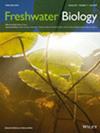Terrestrial Invertebrates Strike Back: Aerial and Ground-Based Colonisation of a Dry Riverbed
IF 2.8
2区 生物学
Q2 ECOLOGY
引用次数: 0
Abstract
- Dispersal, either active or passive, plays a key role in community assembly during the colonisation of newly available habitats such as the dry riverbeds of intermittent rivers. These unstable environments are exposed to an ongoing colonisation process, often from adjacent riparian habitats that are local biodiversity hot spots. We aimed to identify the diversity, origin and colonisation pathways of terrestrial invertebrates in the dry bed of an intermittent Mediterranean river.
- We sampled aerial and ground-dwelling invertebrates during the colonisation of dry riverbeds using cross-vane window traps and pitfall traps. Invertebrate communities were sampled in three habitat types of the intermittent karst Krčić River in Croatia: dry riverbed, riparian and upland habitat. For aerial invertebrates, we differentiated between diurnal and nocturnal colonists and between lateral and longitudinal colonists. All invertebrates were identified to order level, Carabidae, Araneae and Orthoptera to species. Environmental parameters were measured in each habitat.
- Colonisation of the dry riverbed was primarily diurnal. Aerial invertebrates colonised both laterally, from the adjacent riparian habitat, and longitudinally, along the riverbed. Invertebrate catch was positively correlated with wind speed and direction, indicating the importance of passive dispersal by aerial plankton. The ground-dwelling invertebrate community exhibited rapid dry riverbed colonisation, with riparian habitats supporting the highest diversity and unique taxa. Taxonomic metrics showed different patterns for ground-dwelling invertebrates and each studied taxonomic group.
- The observed patterns suggest that ground-dwelling Araneae and Carabidae colonised dry riverbed mostly through spillover from the riparian habitat. In contrast, Orthoptera probably colonised the dry riverbed from the upland habitat. Concurrent sampling of aerial and ground-dwelling colonists characterised responses that could not have been detected using a single method.
- Our study demonstrates that multiple dispersal modes and source habitats are involved in the colonisation of the dry riverbed. Our results underline the importance to conserve riparian and upland areas along intermittent rivers as source habitats during the dry phase. Given the increase in stream intermittency due to climate change, the conservation and restoration of appropriate river landscapes could become more widely relevant in the future.
陆生无脊椎动物反击:干涸河床的空中和地面殖民
无论是主动的还是被动的扩散,在新栖息地(如间歇性河流的干涸河床)的殖民化过程中,在群落聚集中起着关键作用。这些不稳定的环境暴露于持续的殖民化过程中,通常来自邻近的河岸栖息地,这些栖息地是当地生物多样性的热点。我们的目标是确定地中海河流干枯河床上陆生无脊椎动物的多样性、起源和定植途径。我们使用交叉叶片窗诱捕器和陷阱诱捕器对干燥河床定殖期间的空中和地面无脊椎动物进行取样。对克罗地亚间歇喀斯特kr伊奇河3种生境类型(干河床、河岸和高地生境)的无脊椎动物群落进行了研究。对于空中无脊椎动物,我们区分了昼夜迁移和夜间迁移以及横向和纵向迁移。所有无脊椎动物鉴定为目级,蛛形目,蜘蛛目,直翅目为种。测量了各生境的环境参数。在干涸的河床上定居主要是白天进行的。空中无脊椎动物从邻近的河岸栖息地横向迁移,沿着河床纵向迁移。无脊椎动物捕获量与风速和风向呈正相关,表明浮游生物在空中被动传播的重要性。陆生无脊椎动物群落表现出快速的干河床殖民化,河岸生境支持最高的多样性和独特的分类群。地生无脊椎动物和每个研究类群的分类指标表现出不同的模式。观察到的模式表明,地面生活的蜘蛛目和蜘蛛科主要是通过从河岸栖息地溢出来殖民干河床的。相比之下,直翅目昆虫可能从高地栖息地移居到干燥的河床。同时对空中和地面居住的殖民者进行采样,特征是使用单一方法无法检测到的反应。我们的研究表明,多种扩散模式和来源栖息地参与了干涸河床的殖民化。我们的研究结果强调了在干旱期保护间歇河流沿岸和高地地区作为水源栖息地的重要性。鉴于气候变化导致河流断续的增加,保护和恢复适当的河流景观在未来可能变得更加重要。
本文章由计算机程序翻译,如有差异,请以英文原文为准。
求助全文
约1分钟内获得全文
求助全文
来源期刊

Freshwater Biology
生物-海洋与淡水生物学
CiteScore
5.90
自引率
3.70%
发文量
162
审稿时长
2 months
期刊介绍:
Freshwater Biology publishes papers on all aspects of the ecology of inland waters, including rivers and lakes, ground waters, flood plains and other freshwater wetlands. We include studies of micro-organisms, algae, macrophytes, invertebrates, fish and other vertebrates, as well as those concerning whole systems and related physical and chemical aspects of the environment, provided that they have clear biological relevance.
Studies may focus at any level in the ecological hierarchy from physiological ecology and animal behaviour, through population dynamics and evolutionary genetics, to community interactions, biogeography and ecosystem functioning. They may also be at any scale: from microhabitat to landscape, and continental to global. Preference is given to research, whether meta-analytical, experimental, theoretical or descriptive, highlighting causal (ecological) mechanisms from which clearly stated hypotheses are derived. Manuscripts with an experimental or conceptual flavour are particularly welcome, as are those or which integrate laboratory and field work, and studies from less well researched areas of the world. Priority is given to submissions that are likely to interest a wide range of readers.
We encourage submission of papers well grounded in ecological theory that deal with issues related to the conservation and management of inland waters. Papers interpreting fundamental research in a way that makes clear its applied, strategic or socio-economic relevance are also welcome.
Review articles (FRESHWATER BIOLOGY REVIEWS) and discussion papers (OPINION) are also invited: these enable authors to publish high-quality material outside the constraints of standard research papers.
 求助内容:
求助内容: 应助结果提醒方式:
应助结果提醒方式:


